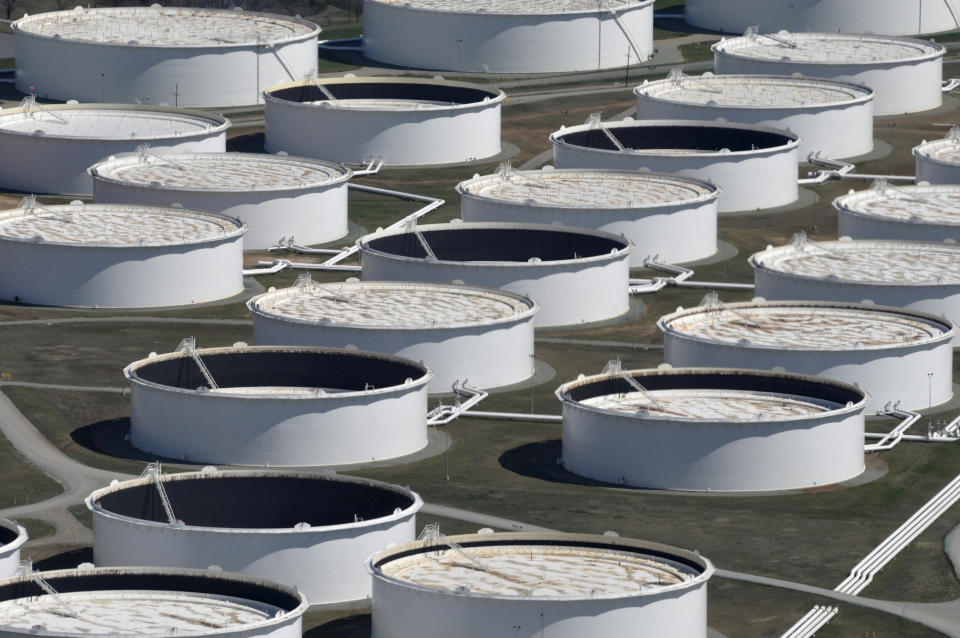Oil is set for 'a violent rebalancing:' Goldman Sachs
Investors should brace for volatile near-term price action in oil before a yawning supply and demand discrepancy for crude comes into equilibrium, according to Goldman Sachs.
In a new note, analyst Damien Courvalin predicted “a violent rebalancing” for the commodity in the month or so ahead.
“As storage becomes saturated, price volatility will remain exceptionally high in coming weeks,” Courvalin said. “But with ultimately a finite amount of storage left to fill, production will soon need to fall sizably to bring the market into balance, setting the stage for higher prices once demand gradually recovers.”
“This inflection will play out in a matter of weeks, not months, with the market likely forced to balance before June,” he added.
On Monday, West Texas intermediate crude oil May futures (CL=F) settled at -$37.63 per barrel, the first time in history that contracts on the commodity fell below zero. While those contracts expire today, the drop in prices has spilled over to the June WTI futures (CLM20.NYM), as well as to Brent (BZ=F), the international benchmark for crude products.
Filling to capacity
At the heart of the crude oil price plunges are concerns that millions of barrels of excess oil will go unused as the coronavirus pandemic, widespread social distancing measures, and travel restrictions decimate global energy demand.
Analysts’ recent estimates for the demand destruction highlight the extent of the problem. Vitol Group estimated that crude consumption had dropped by as much as 20%, or 20 million barrels per day, from the normal level of 100 million barrels per day amid the pandemic.
And in another report, the International Energy Agency said it estimated April demand would be 29 million barrels per day lower than last year, sinking to the lowest level since 1995.

But even as demand drops, U.S. crude inventories have been steadily rising. Commercial crude stockpiles rose by a record 19 million barrels for the week ended April 10, based on the Energy Information Administration’s most recent report, bringing inventories to nearly 504 million barrels and about 6% above the five-year average for this time of year. Domestic crude production edged down slightly – but not nearly enough to offset the build – by 100,000 barrels per day to 12.3 million barrels a day, about matching the level from last August.
At the Cushing, Oklahoma, storage facility — a linchpin for delivery for the West Texas intermediate contract — capacity has virtually hit its cap. Reports of the rapidly filling hub had been a key driver of Monday’s oil price breach below zero for the May WTI contract.
“Any holder of a long position going into settlement would then be obligated to take delivery of crude in Cushing during the month of May,” Courvalin said. “This means that an investor long a WTI May contract would be forced to sell out of this position (at any price) before [Tuesday’s] settlement to avoid being stuck having to find room for barrels in the Cushing storage hub which will likely be completely full by then.”
The Cushing facility was about 77% full as of last Friday, and the past two weeks’ worth of builds point to “stock-out by the first week of May,” Courvalin said.
—
Emily McCormick is a reporter for Yahoo Finance. Follow her on Twitter: @emily_mcck
Read more from Emily:
What we can learn from the 17 stock market crashes since 1870
Nike 3Q revenue tops expectations as surge in China digital sales helps offset store closures
Credit Suisse cuts 2020 S&P 500 outlook, but sees rebound in 2021
Markit U.S. PMI report signals 'steepest downturn since 2009 in March'
Follow Yahoo Finance on Twitter, Facebook, Instagram, Flipboard, LinkedIn, and reddit.
Find live stock market quotes and the latest business and finance news

 Yahoo Finance
Yahoo Finance 